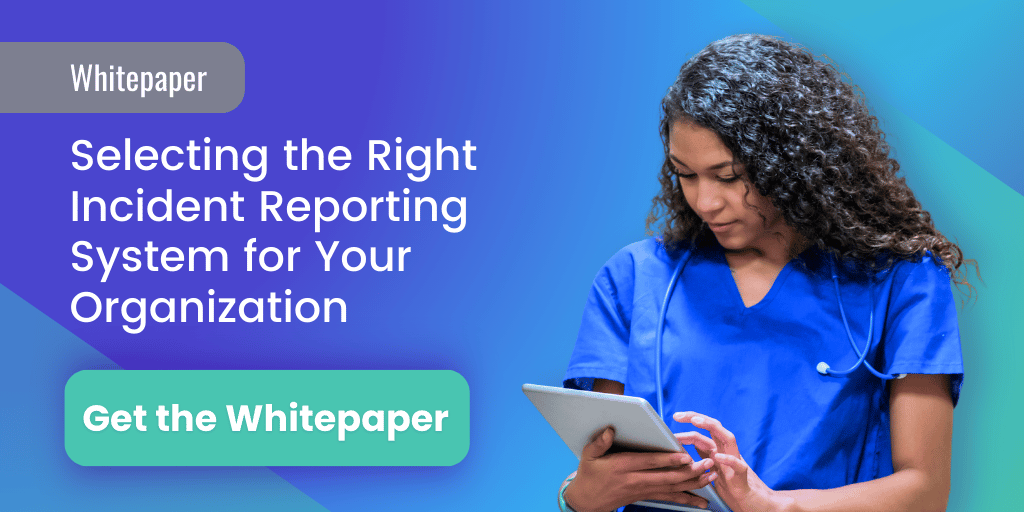5 min read
How Incident Reporting Software Can Bridge Safety Perception Gaps
Performance Health Partners
May 15, 2024

Consider a scenario in a hospital where management believes their emergency protocols are well understood and carefully followed by all staff. Yet, when a crisis arises, some providers hesitate, unclear about certain procedures, revealing a dangerous gap between management’s perception and the actual readiness of their teams. This safety perception gap not only poses risks to patient safety but also to staff morale and the care experience. Bridging such gaps is crucial, and incident reporting software plays a key role, offering a way to enhance communication, compliance, and overall safety within healthcare settings.
Understanding Safety Perception Gaps in Healthcare
It’s critical that healthcare organizations understand safety perception gaps, especially when discrepancies arise between management’s expectations and the actual experiences of frontline staff. These gaps often arise from differences in how safety protocols are comprehended and communicated within the organization.
For instance, while hospital management might think that safety protocols are diligently followed, data from the 2021 AHRQ Hospital Survey on Patient Safety Culture™ (SOPS®) suggests that nurses often report lower perceptions of patient safety compared to other healthcare staff, suggesting a significant perception gap.
This disparity could potentially be influenced by several factors, including the feasibility of implementing these protocols in high-pressure environments like emergency rooms or due to systemic issues such as understaffing and inadequate equipment.

Furthermore, hierarchical communication barriers significantly contribute to these gaps. Management may not always be aware of the realities faced by their staff, primarily if communication channels are not open or effectively used. Workload pressures can also exacerbate these issues, where staff might prioritize urgent care over reporting safety concerns, leading to underreporting of near misses and incidents and a skewed perception of safety from the management’s viewpoint.
Addressing these gaps requires a multifaceted approach, focusing on improving communication channels through practices such as safety huddles and employee rounding, ensuring adequate staffing and resources, and fostering a culture of safety where safety concerns can be freely expressed and addressed. This not only helps in aligning the perceptions of safety between different groups but also enhances the overall safety culture within healthcare organizations.
The Role of Incident Reporting Software
Incident reporting software is designed to streamline the reporting and management of safety incidents within healthcare environments. Key features of this software that are particularly beneficial in healthcare include:
- Confidential Reporting Systems: These systems offer options for anonymous reporting, making it easier for staff to report issues without fear of reprisal.
- Real-Time Data Tracking and Alerts: This feature ensures that any incident is immediately logged and the relevant parties are alerted, facilitating swift action to prevent the recurrence of similar incidents.
- Integration with Hospital Information Systems: Seamless integration with electronic health records (EHRs) and other systems ensures that incident data contributes to comprehensive patient care management.
The many benefits of incident reporting software in healthcare are profound. Improved patient safety; reduced frequency of safety events such as medication errors, inpatient falls, and workplace violence; and optimized compliance with ever-evolving healthcare regulations are just a few of the advantages.
Bridging the Safety Perception Gap with Technology
Incident reporting software is a powerful tool for bridging the safety perception gaps in healthcare by facilitating more transparent and effective communication. This software allows for the anonymous reporting of incidents, which is essential in environments where staff may otherwise feel hesitant to speak up due to fear of reprisal or judgment. By ensuring anonymity, these systems encourage honesty and openness, allowing staff to report near misses and minor issues before they escalate into serious problems.
The real strength of incident reporting software lies in its ability to collect comprehensive data across different levels of an organization. This data can be analyzed to identify trends and patterns that might not be visible at the surface level.
For example, a recurring type of incident reported in different departments might indicate a systemic issue that requires organizational changes, rather than isolated interventions.
Moreover, the insights gained from this data enable healthcare organizations to implement targeted interventions.
A 2022 case study illustrated that a hospital that implemented incident reporting software not only reduced their rates of medication errors by 51% but also significantly improved the alignment between management’s perception of safety and the actual safety experiences reported by frontline staff.
This alignment is critical as it ensures that the management’s strategies and the realities of day-to-day operations are in sync, fostering a culture where safety protocols are more than just procedural—they’re integral to the everyday actions of all staff members.
In this way, incident reporting software streamlines the reporting process, but also acts as a bridge, narrowing the gap between how safety is perceived by different stakeholders within the organization. This is vital for developing a unified approach to patient and healthcare worker safety, enhancing both the effectiveness of safety measures and the overall trust within the organization.
Best Practices for Implementing Incident Reporting Software in Healthcare
Implementing incident reporting software successfully involves several critical steps:
Assessment and Selection
Not all incident reporting software is created equal. That’s why it’s important to select a system that aligns well with the specific needs of your healthcare setting. Look for software that offers high customizability. This is crucial, as healthcare organizations vary greatly in size, specialty, and workflow complexities.
Avoid platforms that are rigidly designed only for large health systems. Consider features like ease of use, integration capabilities, and the type of reports it can generate.
Conducting a thorough needs assessment can help pinpoint which features will best address your organization’s safety concerns.
Integration with Existing Systems
Seamless integration of the incident reporting software with existing hospital protocols and electronic health records (EHR) systems is essential to minimize disruption and enhance utility. Integration ensures that incident data can be easily accessed and utilized within the broader patient management systems, thereby improving response times and facilitating more comprehensive risk management.
Work with software vendors to ensure that the integration process is smooth and that data integrity is maintained across systems.
Training and Cultural Integration
Effective training is necessary for the successful adoption of any new technology, including incident reporting software. Ensure that all staff members, from frontline workers to management, are adequately trained on how to use the software efficiently.
It’s equally important to frame this training within the context of a positive safety culture. Emphasize that the purpose of incident reporting is not to attribute blame but to promote continuous learning and improvement.
Encourage an atmosphere where staff feel safe to report incidents without fear of punishment. This approach helps to ensure that the tool is used as intended and that it contributes to a genuine enhancement in patient safety.
Continuous Evaluation and Improvement
Once implemented, it’s key that you continuously evaluate the effectiveness of the incident reporting software. Regular feedback from users can highlight areas of improvement and help refine the system to better meet the needs of the organization.
Additionally, review the impact of the software on incident management and safety outcomes regularly. Adjust training, policies, and the software itself as needed to ensure that it continues to meet the evolving demands of your healthcare organization.
Leadership and Support
Strong leadership is essential to drive the adoption and proper use of incident reporting software. Leaders should actively support the use of the technology by promoting its benefits and participating in training and engagement activities. This top-down support can significantly influence the staff’s willingness to embrace and effectively use the software.
By following these best practices, healthcare organizations can maximize the benefits of incident reporting software, enhancing both the safety and the quality of care provided to patients.
Final Thoughts
Incident reporting software plays a pivotal role in bridging the safety perception gaps in healthcare, directly addressing discrepancies between the experiences of frontline staff and management’s expectations.
By fostering open communication, enabling anonymous reporting, and facilitating real-time data analysis, this technology ensures that safety concerns aren’t only reported, but also quickly acted upon.
Such systems help align everyone’s understanding of safety protocols, significantly enhancing the safety culture within healthcare organizations. As a result, adopting incident reporting software is a critical step for healthcare facilities aiming to improve safety outcomes and build trust across all levels of their organization.
If your organization is committed to enhancing its safety culture, our team is ready to assist. Learn how our award-winning Incident Reporting System can help you achieve your safety goals by connecting with our team today.



